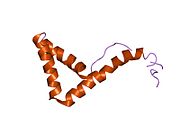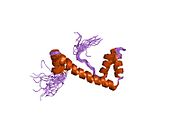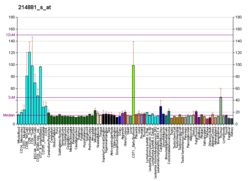UBTF
| UBTF | |||||||||||||||||||||||||||||||||||||||||||||||||||
|---|---|---|---|---|---|---|---|---|---|---|---|---|---|---|---|---|---|---|---|---|---|---|---|---|---|---|---|---|---|---|---|---|---|---|---|---|---|---|---|---|---|---|---|---|---|---|---|---|---|---|---|
 | |||||||||||||||||||||||||||||||||||||||||||||||||||
| |||||||||||||||||||||||||||||||||||||||||||||||||||
| Identifiers | |||||||||||||||||||||||||||||||||||||||||||||||||||
| Aliases | UBTF, NOR-90, UBF, UBF-1, UBF1, UBF2, upstream binding transcription factor, RNA polymerase I, CONDBA, upstream binding transcription factor | ||||||||||||||||||||||||||||||||||||||||||||||||||
| External IDs | OMIM: 600673; MGI: 98512; HomoloGene: 7970; GeneCards: UBTF; OMA:UBTF - orthologs | ||||||||||||||||||||||||||||||||||||||||||||||||||
| |||||||||||||||||||||||||||||||||||||||||||||||||||
| |||||||||||||||||||||||||||||||||||||||||||||||||||
| |||||||||||||||||||||||||||||||||||||||||||||||||||
| |||||||||||||||||||||||||||||||||||||||||||||||||||
| |||||||||||||||||||||||||||||||||||||||||||||||||||
| Wikidata | |||||||||||||||||||||||||||||||||||||||||||||||||||
| |||||||||||||||||||||||||||||||||||||||||||||||||||
Upstream binding transcription factor (UBTF), or upstream binding factor (UBF), is a protein that in humans is encoded by the UBTF gene.[5][6]
Gene
In humans, the UBTF gene encodes a 764 amino acid protein and is located on chromosome 17 at position q21.31.[7][8] In mice, UBTF is found on chromosome 11 [citation needed].
Structure
UBTF contains six high mobility group boxes (HMG-boxes) that allow it to bind to DNA.[9] UBTF also contains a hyperacidic carboxy-terminal domain, which is required for transcription activation, and a helix-gap-helix dimersation motif (as UBTF is thought to often act as a dimer).[9][10]
In humans, alternative splicing can give rise to either the UBTF1 or UBTF2 isoform which are 97 kD and 94 kD in mass, respectively [11] UBTF2 lacks exon 8 of the larger UBTF1 isoform which encodes a portion of HMG Box 2.[12]
Function
UBTF is a transcription factor required for expression of the 18S, 5.8S, and 28S ribosomal RNAs, along with SL1 (a complex of TBP (MIM 600075) and three TBP-associated factors or 'TAFs')[citation needed].
UBTF is a nucleolar phosphoprotein with both DNA binding and transactivation domains. Sequence-specific DNA binding to the core and upstream control elements of the human rRNA promoter is mediated through several HMG boxes.[13] [supplied by OMIM][6]
In vertebrates, UBTF plays a crucial role in maintaining rDNA chromatin in a euchromatic state. Consequently, UBTF binding is one of the characteristics of euchromatic, transcriptionally active rDNA repeats.[14]
UBTF2 has been found to regulate mRNA transcription by RNA Polymerase II.[9]
Clinical significance
UBTF may have a role in cancer. Increased UBF binding to rDNA has been observed in cancer cells and is associated with elevated rDNA transcription and tumor cell survival.[15] Supporting this, it was found that cisplatin, a chemotherapy drug, can displace UBTF from rDNA, causing a reduction in rRNA synthesis and subsequent p53-independent apoptosis.[16]
Additionally, UBTF has been found to facilitate melanoma by promoting GIT1 expression which, in turn, activates MEK1/2-ERK1/2 signaling pathways.[17]
UBTF may also be important to neurological functioning. A de novo gain-of-function mutation to UBTF (c.628G>A) has been found to cause developmental neuroregression.[12] This mutation replaces glutamic acid with lysine at position 210 of the polypeptide chain (p.Glu210Lys) which results in a stronger UBTF interaction with DNA.[18] In 2022, another likely pathogenic variant (Gln203Arg) was identified in a proband with severe early-onset developmental delay..[19]
Interactions
UBTF has been shown to interact with:
References
- ^ a b c GRCh38: Ensembl release 89: ENSG00000108312 – Ensembl, May 2017
- ^ a b c GRCm38: Ensembl release 89: ENSMUSG00000020923 – Ensembl, May 2017
- ^ "Human PubMed Reference:". National Center for Biotechnology Information, U.S. National Library of Medicine.
- ^ "Mouse PubMed Reference:". National Center for Biotechnology Information, U.S. National Library of Medicine.
- ^ Matera AG, Wu W, Imai H, O'Keefe CL, Chan EK (May 1997). "Molecular cloning of the RNA polymerase I transcription factor hUBF/NOR-90 (UBTF) gene and localization to 17q21.3 by fluorescence in situ hybridization and radiation hybrid mapping". Genomics. 41 (1): 135–8. doi:10.1006/geno.1997.4647. PMID 9126496.
- ^ a b "Entrez Gene: UBTF upstream binding transcription factor, RNA polymerase I".
- ^ Jones KA, Black DM, Griffiths BL, Solomon E (Dec 1995). "Localization of the Human RNA Polymerase I Transcription Factor Gene (UBTF) to the D17S183 Locus on Chromosome 17q21 and Construction of a Long-Range Restriction Map of the Region". Genomics. 30 (3): 602–4. doi:10.1006/geno.1995.1283. PMID 8825649.
- ^ Edvardson S, Nicolae CM, Agrawal PB, Mignot C, Payne K, et al. (Aug 2017). "Heterozygous De Novo UBTF Gain-of-Function Variant Is Associated with Neurodegeneration in Childhood". American Journal of Human Genetics. 101 (2): 267–73. doi:10.1016/j.ajhg.2017.07.002. PMC 5544390. PMID 28777933.
- ^ a b c Sanij E, Diesch J, Lesmana A, Poortinga G, Hein N, et al. (Feb 2015). "A novel role for the Pol I transcription factor UBTF in maintaining genome stability through the regulation of highly transcribed Pol II genes". Genome Res. 25 (2): 201–12. doi:10.1101/gr.176115.114. PMC 4315294. PMID 25452314.
- ^ Schnapp G, Santori F, Carles C, Riva M, Grummt I (Jan 1994). "The HMG box-containing nucleolar transcription factor UBF interacts with a specific subunit of RNA polymerase I". EMBO J. 13 (1): 190–9. doi:10.1002/j.1460-2075.1994.tb06248.x. PMC 394792. PMID 394792.
- ^ Bell SP, Learned RM, Jantzen HM, Tjian R (Sep 1988). "Functional cooperativity between transcription factors UBF1 and SL1 mediates human ribosomal RNA synthesis". Science. 241 (4870): 1192–7. Bibcode:1988Sci...241.1192B. doi:10.1126/science.3413483. PMID 3413483.
- ^ a b Toro C, Hori RT, Malicdan MC, Tifft CJ, Goldstein A, et al. (Feb 2018). "A recurrent de novo missense mutation in UBTF causes developmental neuroregression". EMBO J. 27 (4): 691–705. doi:10.1093/hmg/ddx435. PMC 5886272. PMID 29300972.
- ^ Jantzen HM, Admon A, Bell SP, Tjian R (Apr 1990). "Nucleolar transcription factor hUBF contains a DNA-binding motif with homology to HMG proteins". Nature. 344 (6269): 830–6. Bibcode:1990Natur.344..830J. doi:10.1038/344830a0. PMID 2330041. S2CID 4280039.
- ^ Sanij E, Hannan R (Aug 2009). "The role of UBF in regulating the structure and dynamics of transcriptionally active rDNA chromatin". Epigenetics. 4 (6): 374–82. doi:10.4161/epi.4.6.9449. PMID 19717978. S2CID 30922645.
- ^ Diesch J, Bywater MJ, Sanij E, Cameron DP, Schierding W, et al. (Jan 2019). "Changes in long-range rDNA-genomic interactions associate with altered RNA polymerase II gene programs during malignant transformation". Communications Biology. 2: e39(2019). doi:10.1038/s42003-019-0284-y. PMC 6349880. PMID 30701204. S2CID 210151479.
- ^ Hamdane N, Herdman C, Mars J, Stefanovsky V, Tremblay MG, Moss T (Sep 2015). "Depletion of the cisplatin targeted HMGB-box factor UBF selectively induces p53-independent apoptotic death in transformed cells". Oncotarget. 6 (29): 27519–27536. doi:10.18632/oncotarget.4823. PMC 4695006. PMID 26317157.
- ^ Zhang J, Zhang J, Liu W, Ge R, Gao T, et al. (Oct 2021). "UBTF facilitates melanoma progression via modulating MEK1/2-ERK1/2 signalling pathways by promoting GIT1 transcription". Cancer Cell International. 21 (1): 543(2021). doi:10.1186/s12935-021-02237-8. PMC 8522148. PMID 34663332.
- ^ Edvardson S, Nicolae CM, Agrawal PB, Mignot C, Payne K, et al. (Aug 2017). "Heterozygous De Novo UBTF Gain-of-Function Variant Is Associated with Neurodegeneration in Childhood". American Journal of Human Genetics. 101 (2): 267–73. doi:10.1016/j.ajhg.2017.07.002. PMC 5544390. PMID 28777933.
- ^ Tinker RJ, Guess T, Rinker DC, Sheehan JH, Lubarsky D, et al. (Dec 2022). "A novel, likely pathogenic variant in UBTF-related neurodegeneration with brain atrophy is associated with a severe divergent neurodevelopmental phenotype". Molecular Genetics & Genomic Medicine. 10 (12): e2054. doi:10.1002/mgg3.2054. PMC 9747545. PMID 36106513.
- ^ Voit R, Kuhn A, Sander EE, Grummt I (July 1995). "Activation of mammalian ribosomal gene transcription requires phosphorylation of the nucleolar transcription factor UBF". Nucleic Acids Res. 23 (14): 2593–9. doi:10.1093/nar/23.14.2593. PMC 307079. PMID 7651819.
- ^ Hannan KM, Hannan RD, Smith SD, Jefferson LS, Lun M, Rothblum LI (October 2000). "Rb and p130 regulate RNA polymerase I transcription: Rb disrupts the interaction between UBF and SL-1". Oncogene. 19 (43): 4988–99. doi:10.1038/sj.onc.1203875. PMID 11042686.
- ^ Voit R, Grummt I (November 2001). "Phosphorylation of UBF at serine 388 is required for interaction with RNA polymerase I and activation of rDNA transcription". Proc. Natl. Acad. Sci. U.S.A. 98 (24): 13631–6. Bibcode:2001PNAS...9813631V. doi:10.1073/pnas.231071698. PMC 61092. PMID 11698641.
- ^ Zhai W, Comai L (August 2000). "Repression of RNA polymerase I transcription by the tumor suppressor p53". Mol. Cell. Biol. 20 (16): 5930–8. doi:10.1128/mcb.20.16.5930-5938.2000. PMC 86070. PMID 10913176.
- ^ Lin CY, Tuan J, Scalia P, Bui T, Comai L (Dec 2002). "The cell cycle regulatory factor TAF1 stimulates ribosomal DNA transcription by binding to the activator UBF". Curr. Biol. 12 (24): 2142–6. doi:10.1016/s0960-9822(02)01389-1. PMID 12498690. S2CID 16352280.
Further reading
- Chan EK, Imai H, Hamel JC, Tan EM (1991). "Human autoantibody to RNA polymerase I transcription factor hUBF. Molecular identity of nucleolus organizer region autoantigen NOR-90 and ribosomal RNA transcription upstream binding factor". J. Exp. Med. 174 (5): 1239–44. doi:10.1084/jem.174.5.1239. PMC 2119007. PMID 1940801.
- Jantzen HM, Admon A, Bell SP, Tjian R (1990). "Nucleolar transcription factor hUBF contains a DNA-binding motif with homology to HMG proteins". Nature. 344 (6269): 830–6. Bibcode:1990Natur.344..830J. doi:10.1038/344830a0. PMID 2330041. S2CID 4280039.
- Bell SP, Learned RM, Jantzen HM, Tjian R (1988). "Functional cooperativity between transcription factors UBF1 and SL1 mediates human ribosomal RNA synthesis". Science. 241 (4870): 1192–7. Bibcode:1988Sci...241.1192B. doi:10.1126/science.3413483. PMID 3413483.
- Voit R, Kuhn A, Sander EE, Grummt I (1995). "Activation of mammalian ribosomal gene transcription requires phosphorylation of the nucleolar transcription factor UBF". Nucleic Acids Res. 23 (14): 2593–9. doi:10.1093/nar/23.14.2593. PMC 307079. PMID 7651819.
- Hempel WM, Cavanaugh AH, Hannan RD, Taylor L, Rothblum LI (1996). "The species-specific RNA polymerase I transcription factor SL-1 binds to upstream binding factor". Mol. Cell. Biol. 16 (2): 557–63. doi:10.1128/MCB.16.2.557. PMC 231034. PMID 8552083.
- Hanada K, Song CZ, Yamamoto K, Yano K, Maeda Y, Yamaguchi K, Muramatsu M (1996). "RNA polymerase I associated factor 53 binds to the nucleolar transcription factor UBF and functions in specific rDNA transcription". EMBO J. 15 (9): 2217–26. doi:10.1002/j.1460-2075.1996.tb00575.x. PMC 450146. PMID 8641287.
- Pluta AF, Earnshaw WC (1996). "Specific interaction between human kinetochore protein CENP-C and a nucleolar transcriptional regulator". J. Biol. Chem. 271 (31): 18767–74. doi:10.1074/jbc.271.31.18767. PMID 8702533.
- Whitehead CM, Winkfein RJ, Fritzler MJ, Rattner JB (1997). "ASE-1: a novel protein of the fibrillar centres of the nucleolus and nucleolus organizer region of mitotic chromosomes". Chromosoma. 106 (8): 493–502. doi:10.1007/s004120050271. PMID 9426281. S2CID 10684078.
- Voit R, Hoffmann M, Grummt I (1999). "Phosphorylation by G1-specific cdk-cyclin complexes activates the nucleolar transcription factor UBF". EMBO J. 18 (7): 1891–9. doi:10.1093/emboj/18.7.1891. PMC 1171274. PMID 10202152.
- Liu CJ, Wang H, Lengyel P (1999). "The interferon-inducible nucleolar p204 protein binds the ribosomal RNA-specific UBF1 transcription factor and inhibits ribosomal RNA transcription". EMBO J. 18 (10): 2845–54. doi:10.1093/emboj/18.10.2845. PMC 1171365. PMID 10329630.
- Hannan KM, Hannan RD, Smith SD, Jefferson LS, Lun M, Rothblum LI (2000). "Rb and p130 regulate RNA polymerase I transcription: Rb disrupts the interaction between UBF and SL-1". Oncogene. 19 (43): 4988–99. doi:10.1038/sj.onc.1203875. PMID 11042686.
- Kalousek I, Krízková P (2000). "Lymphocyte mitogenic transformation is accompanied by phosphorylation of the nucleolar transcription factor UBF". Cell. Mol. Biol. (Noisy-le-grand). 46 (7): 1163–71. PMID 11075946.
- Pelletier G, Stefanovsky VY, Faubladier M, Hirschler-Laszkiewicz I, Savard J, Rothblum LI, Côté J, Moss T (2000). "Competitive recruitment of CBP and Rb-HDAC regulates UBF acetylation and ribosomal transcription". Mol. Cell. 6 (5): 1059–66. doi:10.1016/S1097-2765(00)00104-0. PMID 11106745.
- Miller G, Panov KI, Friedrich JK, Trinkle-Mulcahy L, Lamond AI, Zomerdijk JC (2001). "hRRN3 is essential in the SL1-mediated recruitment of RNA Polymerase I to rRNA gene promoters". EMBO J. 20 (6): 1373–82. doi:10.1093/emboj/20.6.1373. PMC 145519. PMID 11250903.
- Seither P, Iben S, Thiry M, Grummt I (2001). "PAF67, a novel protein that is associated with the initiation-competent form of RNA polymerase I". Biol. Chem. 382 (8): 1163–70. doi:10.1515/BC.2001.146. PMID 11592397. S2CID 28819190.
- Voit R, Grummt I (2001). "Phosphorylation of UBF at serine 388 is required for interaction with RNA polymerase I and activation of rDNA transcription". Proc. Natl. Acad. Sci. U.S.A. 98 (24): 13631–6. Bibcode:2001PNAS...9813631V. doi:10.1073/pnas.231071698. PMC 61092. PMID 11698641.
- Stefanovsky VY, Pelletier G, Hannan R, Gagnon-Kugler T, Rothblum LI, Moss T (2001). "An immediate response of ribosomal transcription to growth factor stimulation in mammals is mediated by ERK phosphorylation of UBF". Mol. Cell. 8 (5): 1063–73. doi:10.1016/S1097-2765(01)00384-7. PMID 11741541.
- Andersen JS, Lyon CE, Fox AH, Leung AK, Lam YW, Steen H, Mann M, Lamond AI (2002). "Directed proteomic analysis of the human nucleolus". Curr. Biol. 12 (1): 1–11. doi:10.1016/S0960-9822(01)00650-9. PMID 11790298. S2CID 14132033.
- Dühr S, Torres-Montaner A, Astola A, García-Cozar FJ, Pendón C, Bolívar J, Valdivia MM (2001). "Molecular analysis of the 5' region of human ribosomal transcription factor UBF". DNA Seq. 12 (4): 267–72. doi:10.3109/10425170109025001. PMID 11916260. S2CID 11173681.
- v
- t
- e
-
 1k99: Solution Structure of the first HMG box in human Upstream binding factor
1k99: Solution Structure of the first HMG box in human Upstream binding factor -
 1l8y: Solution structure of HMG box 5 in human upstream binding factor
1l8y: Solution structure of HMG box 5 in human upstream binding factor -
 1l8z: Solution structure of HMG box 5 in human upstream binding factor
1l8z: Solution structure of HMG box 5 in human upstream binding factor -
 1v63: Solution structure of the 6th HMG box of mouse UBF1
1v63: Solution structure of the 6th HMG box of mouse UBF1 -
 1v64: Solution structure of the 3rd HMG box of mouse UBF1
1v64: Solution structure of the 3rd HMG box of mouse UBF1 -
 1wgf: Solution structure of the 4th HMG-box of mouse UBF1
1wgf: Solution structure of the 4th HMG-box of mouse UBF1
 | This article on a gene on human chromosome 17 is a stub. You can help Wikipedia by expanding it. |
- v
- t
- e
























